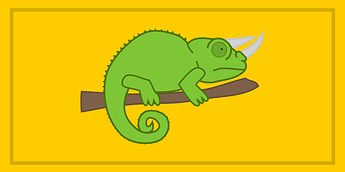Flag:
Nation Name (long): The Grand Union of Kinyonga
Nation Name (short): Kinyonga
National Animal: Chameleon (Trioceros jacksonii)
National Plant: Cassava
Capitol: Matumaini
Largest City: Matumaini
Demonym: Kinyongese
Language: Kinyongese (Swahili)
Species: Mostly human, significant Cava population
Population: 89M
Government type: Dominant-party parliamentary confederacy
Leader(s): Kiongozi
Legislature: Sauti ya Umoja
Formation: Early-mid 1900s (modern government, a less widespread coalition of polities existed for a long time, but was dismantled under colonial rule)
Total GDP: 267B SHD
GDP per capita: 3000 SHD
Currency: Mikia (MKA)
Calling Code: TBD
ISO 3166 code: KYG
Internet TLD: .kg
Historical Summary:
The islands which are today controlled by this state have long been home to numerous peoples, have seen periods of peace and war, alliances and rivalries. By the end of the first millennium of the common era, the various polities began to coalesce into a larger alliance, which called itself Kinyonga. This name is taken from the Kinyongese name for the chameleon, and was chosen due to its near universality across the various religious traditions in the archipelago, representing the powers of life and death.
Centralization accelerated dramatically from (circa) 1000-1300, as the wealth generated from trade grew substantially due to the new access to Auroran markets. Seafaring had also been an early Kinyongese tradition, a necessity for some groups in this area, developing and refining the mtepe, a clinker-built sewn sailboat that was effective at travelling the open seas. By far the largest and most important export was coffee, particularly in the Kormistazic and Qayami markets. The beverage came to occupy an important role in both societies, especially in Qayam due to the religious restrictions on the consumption of alcohol. In most Qayami communities to this day, the coffee house occupies the same role a tavern would in many other cultures.
The late 1200s also marked the beginnings of Auroran colonialism in Arcturia. The Qayami were particularly intent on controlling the coffee trade more directly, as it was now fully dependent on it. While they were already capable of sailing, Qayami boats were vastly inferior to the Kinyongese mtepe, and hence plagiarized their designs and techniques (sometimes stealing the boats outright) in order to more easily expand westward. Qayam established a few ports and stopping points along the Arcturian coast, notably Qalabarid, Mina Mwatadil (modern-day Quariin), and Minaltajir.
Having arrived at the doorstep of the lands they called Arkhabil Alqahwah (or simply Qahwah, lit. Coffee Archipelago), the Qayami began to trade with the Kinyongese directly. A few decades later, they purchased land near the Kinyongese capital and founded the modern settlement of Bandari Ndege, the first Auroran port on Kinyonga proper.
During a period of internal political instability in Kinyonga, the hakim (colonial governor) of Muštamarah conquered several coastal cities and installed a puppet ruler as leader of the southern half of the main island. This is generally understood to mark the end of the original state of Kinyonga, although a significantly weakened independent entity continued to limp along in the north. Though these actions were not approved by the khalifah at the time, the hakim was eventually pardoned. Modern historians have attributed these actions to colonial ambitions and to political pressure from powers within the Khilafah due to coffee shortages. Several other Auroran powers took advantage of this period as well, establishing their own ports.
Some time later, a similar pattern would repeat in the north, installing another puppet dictator on the interior and controlling several port cities directly.
Following some internal strife in the Khalifah, (I won’t go into more detail here is this is more Qayami history) the khalifah was deposed and went into exile in Muštamarah, where he re-declared himself khalifah. This split the realm in two, the exiled khalifah laying claim to everything north of Muštamarah, including everything in former Kinyonga. In desperate need of money, he sold several port cities to other powers, but still retained a controlling share over the islands.
[skipping a bit]
In the late 1800s, Muštamarah lost its grip over one of the puppet states, paving the way for the modern nation of today. Throughout the early-mid 1900s, through wars, deals, and treaties, the Kinyongese regained control over their island city by city.
Once most of the work had been done, the provisional government was dissolved, and the modern structures of power were put in place. The Wanaharakati, the party which most former revolutionaries chose to join, has been in charge of the country since its first elections. Though the veracity of the elections have been called into question, the country has remarkably little corruption compared to its economic peers, and most citizens believe the government is overall well-intentioned. Quality of life for the average citizen has slowly improved, though progress is slow in the large, relatively poor nation.
Muštamarah still claims some Kinyongese land to this day, though most of it is under de facto Kinyongese control. Fighting breaks out occasionally, though usually in isolated incidents. An uneasy peace mostly rests over these regions.
The government of Qayam and the khalifah have since apologized to the Kinyongese people for their role in the brutal colonial period, and have many ongoing projects to help the nation. Most years, a plurality of humanitarian aid (government and charities) from Qayam goes to Kinyonga.

